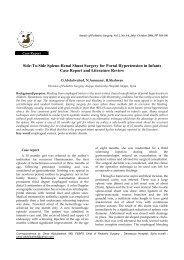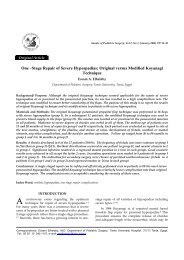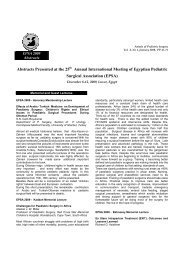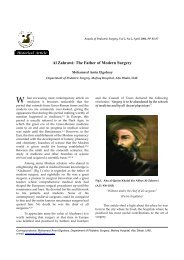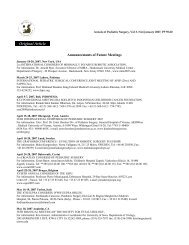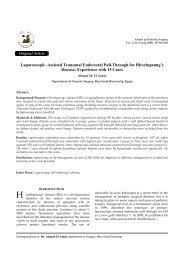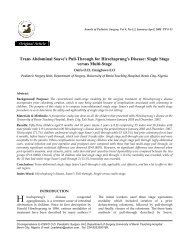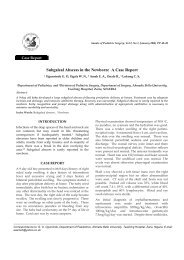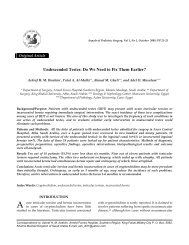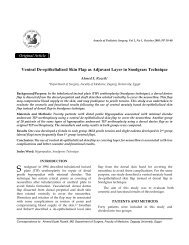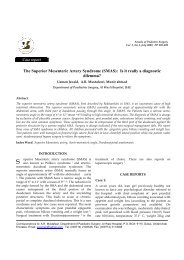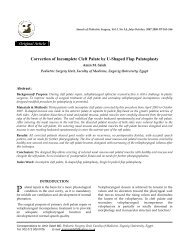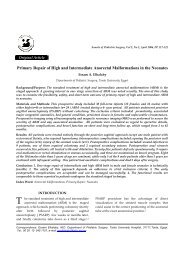Closure of Palatal Fistula with Bucco-labial Myomucosal Pedicled Flap
Closure of Palatal Fistula with Bucco-labial Myomucosal Pedicled Flap
Closure of Palatal Fistula with Bucco-labial Myomucosal Pedicled Flap
You also want an ePaper? Increase the reach of your titles
YUMPU automatically turns print PDFs into web optimized ePapers that Google loves.
Annals <strong>of</strong> Pediatric Surgery,<br />
Vol 5, No 2, April 2009, PP 104-108<br />
Original Article<br />
<strong>Closure</strong> <strong>of</strong> <strong>Palatal</strong> <strong>Fistula</strong> <strong>with</strong> <strong>Bucco</strong>-<strong>labial</strong> <strong>Myomucosal</strong> <strong>Pedicled</strong> <strong>Flap</strong><br />
Mohamed M. EL-Leathy* and Mohamed F. Attia**<br />
Pediatric Surgery Unit*, ENT Department**, Al-Azhar University<br />
ABSTRACT:<br />
Background/Purpose: Oro-nasal fistula is not uncommon complication <strong>of</strong> palatoplasty. Current methods for fistula repair<br />
utilize mucoperiosteal flaps or pedicled flaps. These procedures are <strong>of</strong>ten cumbersome and leave a raw nasal or oral surface,<br />
which may increase the incidence <strong>of</strong> postoperative problems. In addition, the recurrence rate <strong>of</strong> the fistula is as high as 34%<br />
following such procedures. In this study, the authors innovates a simple bucco-<strong>labial</strong> myomucosal pedicled flap method for<br />
fistula repair to avoid recurrences.<br />
Patients and Method: twenty patients <strong>with</strong> palatal fistulae were included, all were previously operated for cleft palate<br />
using a palatal mucoperiosteal flap. Patients <strong>with</strong> palatal fistulas were operated on at least 6 months after palatoplasty and<br />
were all followed up for more than 2 years. A standard bucco-<strong>labial</strong> myomucosal pedicled flap from the nearest area to the<br />
fistula is raised on the oral side. Fashioning <strong>of</strong> a raw area all around the fistula then suturing the pedicled flap to the created<br />
raw area centering the hole <strong>of</strong> the fistula. Weaning <strong>of</strong> the flap can be done after suitable time i.e. after 3 months after<br />
operation.<br />
Results: In all cases, the fistula was healed completely at first attempt <strong>with</strong>out complications. All patients were followed for<br />
at least 2 years, <strong>with</strong>out evidence <strong>of</strong> recurrence.<br />
Conclusion: The authors recommend using the bucco-<strong>labial</strong> myomucosal pedicled flap for the repair <strong>of</strong> postpalatoplasty oronasal<br />
fistulas<br />
Index words: palatal fistula, bucco-<strong>labial</strong> myomucosal pedicled flap.<br />
INTRODUCTION<br />
<strong>Fistula</strong> formation is not uncommon complication <strong>of</strong><br />
primary palatoplasty. The actual reported incidence <strong>of</strong><br />
this complication varies widely, ranging from 0% to<br />
68% in published reports. 1 Although postpalatoplasty<br />
fistulas may occur anywhere along the site <strong>of</strong> the<br />
original cleft(s), they are more common on the hard<br />
palate (Fig.1) and at the junction <strong>of</strong> the hard and s<strong>of</strong>t<br />
palate (Fig.2). 2<br />
Multiple etiologies have been proposed for the<br />
formation <strong>of</strong> fistula following cleft palate repair: 1-<br />
Tissue breakdown due to tension at the site <strong>of</strong> wound<br />
closure. 5 2- Tension after maxillary orthodontics. 3-<br />
Infection. 3 4- Hypoxemia. 2 , and, rarely, 5- hematoma<br />
formation. However, it appears that necrosis <strong>of</strong> the<br />
mucoperiosteal flap, used for cleft closure, is the most<br />
common cause <strong>of</strong> simple fistula formation, especially<br />
when the greater palatine arteries have been injured. 5<br />
Controversy exists regarding the possible<br />
predisposing factors for post palatoplasty fistula<br />
formation. Although Emory et al 1 reported a slight<br />
increase in the incidence <strong>of</strong> fistulas for patients<br />
operated prior to the age <strong>of</strong> 12 months, the relevance<br />
is unclear since the argument was made that the more<br />
experienced surgeon tended to operate on these<br />
younger patients. Other reports emphasize the<br />
importance <strong>of</strong> the size 2 and type <strong>of</strong> original defect,<br />
whether unilateral or bilateral clefts were present 9 ,<br />
the technique used to close the cleft 2 , patient sex 6 ,<br />
Correspondence to: Mohamed M. EL-Leathy, Pediatric Surgery Unit, Al-Azhar University.
El-Leathy M, Attia M<br />
and associated anomalies. <strong>Palatal</strong> fistulas are <strong>of</strong>ten<br />
symptomatic, depending on the size and location <strong>of</strong><br />
the fistula. Symptoms include hypernasality <strong>of</strong><br />
phonation due to audible nasal air escape during<br />
speech, leakage <strong>of</strong> fluids into the nasal cavity, and<br />
lodging <strong>of</strong> food <strong>with</strong> risk <strong>of</strong> infection. Depending on<br />
the extent <strong>of</strong> functional impairment, a palatal fistula<br />
may have psychological, social, and developmental<br />
consequences and should be repaired.<br />
Surgical repair <strong>of</strong> palatal fistulas can be technically<br />
difficult, most <strong>of</strong>ten due to the paucity <strong>of</strong> local tissue<br />
for closure or excessive scarring in the same area as a<br />
result <strong>of</strong> the previous repair or repairs. Several<br />
techniques have been described to circumvent these<br />
problems, including the use <strong>of</strong> tongue flaps 7 , buccal<br />
musculomucosal flaps 8 , mucoperiosteal alveolar<br />
ridge tissue, and mucoperiosteal elevations. 9<br />
Although these methods may have their advantages<br />
in certain cases, most are relatively cumbersome and<br />
are <strong>of</strong>ten complicated by postoperative risks an d<br />
problems; examples include tissue loss elsewhere,<br />
hindering <strong>of</strong> maxillary growth as a result <strong>of</strong> scar<br />
contracture, poor aesthetic result and most<br />
importantly, recurrence <strong>of</strong> the fistula <strong>with</strong> an<br />
incidence as high as 34%. 2 We have, therefore,<br />
developed a simple and efficacious way to close<br />
postpalatoplasty fistulas in an attempt to avoid these<br />
problems.<br />
PATIENTS AND METHODS<br />
Subjects:<br />
The study included twenty patients, sixteen males<br />
and four females. Their ages ranged from 16months to<br />
8 years. All patients had undergone their cleft palatal<br />
repair between 10 months and 2 years <strong>of</strong> age, using a<br />
palatal mucoperiosteal flap (Veau-Wardill-Killner<br />
type) at our facility. All patients had originally been<br />
operated on to repair the cleft palate by the pediatric<br />
or plastic surgery specialist in a well equipped<br />
centers. An oro-nasal fistula was defined as any<br />
palatal defect posterior to the incisive foramen.<br />
Patients <strong>with</strong> palatal fistulas were operated on at least<br />
6 months after palatoplasty and were all followed up<br />
for more than 2 years. The original cleft palatal defects<br />
included 12 cases <strong>of</strong> bilateral cleft lip and palate and 8<br />
cases <strong>of</strong> unilateral cleft lip and palate.<br />
Procedure:<br />
Proper classic preoperative preparation for all<br />
patients was done including clinical assessment and<br />
laboratory investigations in the form <strong>of</strong> complete<br />
blood count, renal and liver function tests, serum<br />
proteins, blood sugar level and local swab for culture<br />
and sensitivity test. Well informed written consents<br />
were taken from the parents.<br />
Operations were performed under general<br />
endotracheal intubation anesthesia supplemented<br />
<strong>with</strong> local infiltration <strong>of</strong> 0.5% Xylocaine <strong>with</strong> 1:100,000<br />
epinephrine into the palate mucosa all around the<br />
fistula opening. A myomucosal pedicled flap from<br />
buccal surface <strong>of</strong> the upper lip or the oral surface <strong>of</strong><br />
the cheek was elevated up to the gingivo-<strong>labial</strong> fold<br />
<strong>with</strong> no importance to the base, length and breadth<br />
proportionality (Fig.3). The edges <strong>of</strong> the palatal fistula<br />
from 3 to 5 mm all around were desquamated <strong>with</strong><br />
dermabrasion instrument (Fig.4).<br />
The flap was fixed on to the raw area <strong>of</strong> the palate<br />
<strong>with</strong> fistulous opening in the center. The flap was<br />
sutured to the raw desquamated area using the Vicryl<br />
sutures 5/0 rounded needle by simple interrupted<br />
sutures (Fig.5).<br />
In six cases, the crossing pedicles <strong>of</strong> the flaps crossed<br />
the alveolar margin at the site <strong>of</strong> alveolar margin<br />
defects. These pedicles were used to repair the defects<br />
after de-epithelialization <strong>of</strong> the defected sites (Fig.6)<br />
In the other fourteen cases, the pedicle crossed a<br />
healthy normal alveolar margin. So weaning <strong>of</strong> the<br />
pedicle was done easily 3 months after repair <strong>of</strong> the<br />
fistula as no synechea were formed at the crossing site<br />
(Fig. 7&8).<br />
The buccal donor site was closed primarily <strong>with</strong><br />
interrupted 5-0 Vicryl sutures.<br />
I.V fluids were given postoperatively for 24 hours,<br />
fluid diet was allowed for 1 week then oral semisolid<br />
foods for another 1 week before normal feeding was<br />
achieved. Children were followed up postoperatively<br />
weekly for one month then follow-up appointments at<br />
3, 6, 12, and 24 months<br />
RESULTS<br />
<strong>Fistula</strong> sizes ranged from 5mm to 16 mm (mean 7.3<br />
mm). <strong>Fistula</strong>s were located at the middle to posterior<br />
aspect <strong>of</strong> the hard palate in five patients, and at the<br />
anterior part <strong>of</strong> the hard palate in fifteen patients. In<br />
all cases, the fistula was completely healed at first<br />
attempt, <strong>with</strong> excellent functional results and no<br />
evidence <strong>of</strong> recurrence <strong>with</strong> a follow up <strong>of</strong> at least 24<br />
months (Fig.9)<br />
105 Vol 5, No 2, April 2009
El-Leathy M, Attia M<br />
Fig 1. A photograph showing an anterior oro-nasal<br />
fistula in the hard palate after palatoplasty.<br />
Fig 2. A photograph showing oro-nasal fistula at the junction<br />
between s<strong>of</strong>t and hard palate opposite the greater palatine<br />
artery.<br />
Fig 3. A Photograph showing myomucosal pedicled<br />
flap separated from the inner surface <strong>of</strong> the upper lip<br />
<strong>with</strong> good vascularity.<br />
Fig 4. A Photograph showing dermabrasion during creation the<br />
de-epithelialised area all around the fistula opening<br />
Fig 5. A photograph showing a non tension arrest <strong>of</strong><br />
the pedicled flap as recipient area <strong>with</strong> proper covering<br />
<strong>of</strong> the fistula opening.<br />
Fig 6. A photograph showing the flap after suturing using vicryl<br />
stitch <strong>with</strong> its pedicle placed to correct the alveolar margin<br />
defect.<br />
Annals <strong>of</strong> Pediatric Surgery 106
El-Leathy M, Attia M<br />
Fig7. A photograph showing the healed buccal flap<br />
<strong>with</strong> a guide wire under its pedicle as there is no<br />
fibrosis or adhesions below.<br />
Fig 8. A photograph showing the buccal flap after cutting its<br />
pedicle (weaning)<br />
Fig 9. A photograph showing a completely healed pedicle <strong>with</strong> good vascularity sealing the alveolar margin<br />
defect which needs no weaning.<br />
DISCUSSION<br />
Methods currently employed for fistula repair can be<br />
broadly divided in two groups: those that use<br />
mucoperiosteal flaps in one way or another, e.g.,<br />
hinge flaps 10 , and those that make use <strong>of</strong> additional<br />
tissue to close the defect. Sources <strong>of</strong> additional tissue<br />
are usually in the form <strong>of</strong> pedicled flaps from<br />
elsewhere in the mouth, according to the site <strong>of</strong> fistula<br />
e.g., buccal mucosa 8 or tongue flaps. 7 The simplest<br />
way to close a fistula is by raising a mucoperiosteal<br />
flap, as in primary cleft palate repair; but it is not the<br />
most successful one due to variable local causes e.g.<br />
scarring, inadequate palatal tissue and/or local<br />
ischemia.<br />
Reasonable results have been obtained in this study<br />
using virgin highly vascular new tissue from the<br />
neighboring buccal surface <strong>of</strong> the upper lip up to the<br />
gingivo-<strong>labial</strong> fold or buccal surface <strong>of</strong> the cheek. The<br />
used flap has a double blood supply, first supply is<br />
from the pedicle and the second supply is from the<br />
raw de-epithelialised surface done by dermabrasion<br />
all around the fistula opening.<br />
Intuitively, one-layer closures using mucoperiosteal<br />
flap i.e. hinge flap will leave a raw surface on the<br />
buccal side that is usually prone to bleeding and/or<br />
improper healing <strong>with</strong> high incidence <strong>of</strong> fistula<br />
recurrence. In this study there is no need to do that, so<br />
the net result repair <strong>of</strong> fistula is devoid <strong>of</strong> local tissue<br />
trauma or tension at sutures line.<br />
Postpalatoplasty oro-nasal fistulas in cleft palate<br />
patients are notoriously difficult to reconstruct, <strong>with</strong><br />
an accepted treatment failure rate <strong>of</strong> at least 10%. 6 The<br />
107 Vol 5, No 2, April 2009
El-Leathy M, Attia M<br />
complete absence <strong>of</strong> complications and, in particular,<br />
no recurrence <strong>of</strong> fistulas in the present study is<br />
extremely promising and encouraging for future<br />
application <strong>of</strong> this approach.<br />
Traditionally, the development <strong>of</strong> speech begins<br />
around 10 months <strong>of</strong> age. Quantization <strong>of</strong> the extent<br />
<strong>of</strong> functional impairment secondary to palatal fistula<br />
may be difficult. Nasality <strong>of</strong> speech is greatly<br />
influenced by the presence <strong>of</strong> a palatal fistula. This<br />
can be detrimental in the development <strong>of</strong> the child<br />
and should thus be corrected as soon as feasible. the<br />
authors therefore chose to perform fistula repair as<br />
early as possible but not before 6 months <strong>of</strong> diagnosis<br />
to allow enough time for the fistula to completely<br />
declare itself.<br />
Although the authors realize that prevention is<br />
always better than cure, fistula formation after cleft<br />
palate repair will probably continue to occur even in<br />
the best <strong>of</strong> hands. It is <strong>of</strong> the utmost importance to<br />
repair symptomatic fistulas as soon as possible, before<br />
further complications and long-term functional<br />
disability develops. The authors are convinced that<br />
the proposed technique is safe, relatively<br />
uncomplicated, and effective. The same technique<br />
could also be used in primary cleft palate repair when<br />
the defect is wide or in cases <strong>of</strong> crippled and<br />
neglected cases.<br />
CONCLUSION<br />
We have successfully treated twenty patients <strong>with</strong><br />
palatal fistula using the described method <strong>with</strong>out<br />
encountering any complications, immediate or longterm.<br />
Validation <strong>of</strong> our application will need to be<br />
shown <strong>with</strong> further use and, hopefully, consistent<br />
results. At the present time, The authors hope that the<br />
reader will consider our proposed method an<br />
appealing alternative possibility.<br />
REFERENCES<br />
1. Emory RE, Clay RP, Bite U, et al. <strong>Fistula</strong> formation and<br />
repair after palatal closure: an institutional perspective.<br />
Plast Reconstr Surg. 99: 1535-1538, 1997<br />
2. Cohen SR, Kalinowski J, LaRossa D,et al .Cleft palate<br />
fistulas: a multivariate statistical analysis <strong>of</strong> prevalence,<br />
etiology and surgical management. Plast Reconstr Surg.<br />
87:1041-1047, 1991<br />
3. McClelland RMA, Patterson TJS. The influence <strong>of</strong><br />
penicillin on the complication rate after repair <strong>of</strong> clefts <strong>of</strong> the<br />
lip and palate. Br J Plant Surg. 16:144-145, 1963<br />
4. Wood FM. Hypoxia: another issue to consider when<br />
timing cleft repair. Ann Plast Surg. 32:15-20, 1994<br />
5. Reid DAC. <strong>Fistula</strong>e in the hard palate following cleft<br />
palate surgery. Br J Plast Surg. 15:377-384, ١٩٦٢<br />
6. Amaratunga NA. Occurrence <strong>of</strong> oronasal fistulas in<br />
operated cleft palata patients. J Oral Maxill<strong>of</strong>acial Surg.<br />
46:834-837, ١٩٩٨<br />
7. Argamaso R.V. The tongue flap: placement and fixation<br />
for closure <strong>of</strong> postpalatoplasty fistulae. Cleft Palate J. 27:402-<br />
410, ١٩٩٠<br />
8. Nakakita N, Maeda K, Ando S, et al . Use <strong>of</strong> a buccal<br />
musculomucosal flap to close palatal fistulae after cleft<br />
palate repair. Br J Plast Surg. 43:452-456, ١٩٩٠<br />
9. Stark RB. Cleft palate. In: Stark RB, ed. Plastic Surgery <strong>of</strong><br />
the Head and Neck New York: Churchill Livingstone; 1300-<br />
1301, 1997.<br />
10. Rintala AE. Surgical closure <strong>of</strong> palatal fistulae: follow-up<br />
<strong>of</strong> 84 personally treated cases. Scand J Plast Reconstr Surg.<br />
14:235-238, ١٩٨٠<br />
Annals <strong>of</strong> Pediatric Surgery 108



